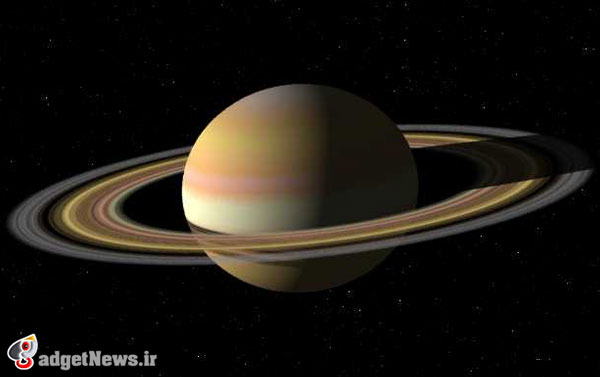
تحقیقات اخیر نشان می دهند که حلقه های دلفریب زحل به احتمال زیاد حدود ۴/۴ میلیارد سال پیش- اندکی پس از شکل گیری سیاره- شکل گرفتند.در ادامه با گجت نيوز همراه باشيد.
مدت ها بود که منشاء شکل گیری حلقه های زحل محل بحث سیاره شناسان قرار داشت. عده ای معتقدند که این حلقه نسبتاً جوان انند و عده ای دیگر بر این باورند که این حلقه ها بسیار قدیمی ترند و همزمان با قمرهای زحل دور این سیاره ی گازی شکل گرفته اند.
تحقیقات اخیر که روی داده های فضاپیمای کاسینی انجام شده٬ صحت سناریوی دوم را تقویت می کند. نتایج این تحقیقات در ۱۰ سپتامیر در نشست سالانه ی اتحادیه ی زمین فیزیک آمریکا اعلام شد.
ساشا کمپف٬ از دانشگاه کلورادو می گوید: «اندازه گیری های کاسینی نشان می دهد که حلقه ی اصلی زحل بسیار قدیمی است؛ بسیار بیشتر از چند صد میلیون سال.»
حلقه ی اصلی زحل بسیار بزرگ است اما ضخامت بسیار کمی دارد؛ به طوری که ۲۸۰ هزار کیلومتری را می پوشاند اما اندازه ی عمودی اش فقط ۱۰ متر است. این حلقه های عمدتاً از یخ آب تشکیل شده اند اما تکه های کوچکی از مواد سنگی- که محصول بمباران های ریزشهاب واره ای اند- نیز در این حلقه ها دیده می شود.
کمپف و همکارانش با استفاده از ابزار تحلیل گر غبار کیهانی کاسینی٬ میزان توزیع این ذرات سنگی کوچک را در سیستم حلقه های زحل اندازه گیری کردند.
آن ها دریافتند که مقدار بسیار اندکی از ذرات غباری با حلقه ها در تماس آند. درواقع به طور میانگین٬ درهر ثانیه حدود ۱۹-۱۰ گرم از این غبارها در هر سانتی متر مربع وجود دارد که در فاصله ی حدود ۵ تا ۵۰ برابر شعاع زحل به دور آن در حرکت اند.
دانشمندان با اندازه گیری نرخ بسیار اندک میزان جذب غبارها نتیجه گرفتند که حلقه ها به احتمال قوی حدود ۴/۴ میلیارد سال پیش شکل گرفته اند.
علاوه براین٬ گروه پژوهش موفق شد مدار بسیاری از این ذرات ریز را بازسازی کند که نشان می داد منشاء بسیاری از آن ها در نواحی دوردست شامل کمربند کایپر٬ ابر اورت و حتی فضای میان ستاره ای است.
همین موضوع٬ شرایط غباری حول زحل را از دیگر نواحی منظومه ی شمسی مانند زمین و بخش های درونی منظومه ی شمسی متمایز می کند. زیرا این ذرات برای رسیدن به نواحی داخلی باید از سدّ گرانشی قدرتمند مشتری عبور کنند که بسیاری از اجسام را به سوی خود می کشد.
کمپف می گوید: «با توجه به شرایط غباری می توان گفت که درواقع مشتری منظومه ی شمسی را به دو بخش داخلی و خارجی تقسیم کرده است.»
مأموریت کاسینی حدود ۳/۲ میلیارد دلار هزینه در برداشته است. این فضاپیما در سال ۱۹۹۷ از زمین پرتاب شد و در سال ۲۰۰۴ به زحل رسید. مأموریت کاسینی تا سال ۲۰۱۷ بسط داده شده است و سرانجام طی برخوردی دراماتیک به جوّ زحل به زندگی خود پایان خواهد داد.
منبع : space
Age of Saturn's Rings Revealed
Saturn's iconic rings likely formed about 4.4 billion years ago, shortly after the planet itself took shape, a new study suggests.
The origin of Saturn's ring system has long been the subject of debate, with some researchers arguing that it's a relatively young structure and others holding that it coalesced long ago, at roughly the same time as the gas giant's many satellites.
The new study, conducted using data gathered by NASA's Saturn-orbiting Cassini spacecraft, strongly supports the latter scenario, researchers said here Tuesday (Dec. 10) at the annual meeting of the American Geophysical Union. [Photos: Saturn's Glorious Rings Up Close]
Cassini's measurements imply that "the main rings would be [extremely] old, rather than hundreds of millions of years old," Sascha Kempf, of the University of Colorado in Boulder, said.
Saturn's main ring system is huge but razor-thin, measuring about 175,000 miles (280,000 kilometers) across but just 33 feet (10 meters) or so in the vertical direction. The rings are composed primarily of water ice, but they contain small amounts of rocky material contributed by micrometeoroid bombardment.
Kempf and his colleagues used Cassini's Cosmic Dust Analyzer instrument to measure just how frequently such tiny particles cruise through the Saturn system.
They found that a surprisingly small amount of dusty material comes into contact with the rings. On average, just 0.0000000000000000001 grams — or, in scientific notation, 10^-19 g — of dust per square centimeter zooms through space every second at a distance of five to 50 Saturn radii from the planet.
Having measured this low rate of dust recruitment, the team then calculated that the rings have likely existed for about 4.4 billion years.
"It would be consistent with an old ring system," Kempf said.
Kempf and his colleagues were also able to reconstruct the orbits of many of these particles, finding that the lion's share likely come from the Kuiper Belt, the ring of icy bodies beyond Neptune's orbit. However, some of the dust probably hails from the even more distant Oort Cloud and some from interstellar space, Kempf said.
That makes the Saturn-area dust quite different from the stuff seen near Earth and other parts of the inner solar system — a situation caused by Jupiter and its huge gravitational pull.
"Jupiter is basically splitting the solar system with respect to the dust into an inner and an outer system," Kempf said.
The $3.2 billion Cassini mission launched in 1997 and reached Saturn in 2004. The mission's operations have been extended through 2017, when the spacecraft will end its life with a dramatic plunge into Saturn's atmosphere.
 گجت نیوز آخرین اخبار تکنولوژی، علم و خودرو
گجت نیوز آخرین اخبار تکنولوژی، علم و خودرو 





